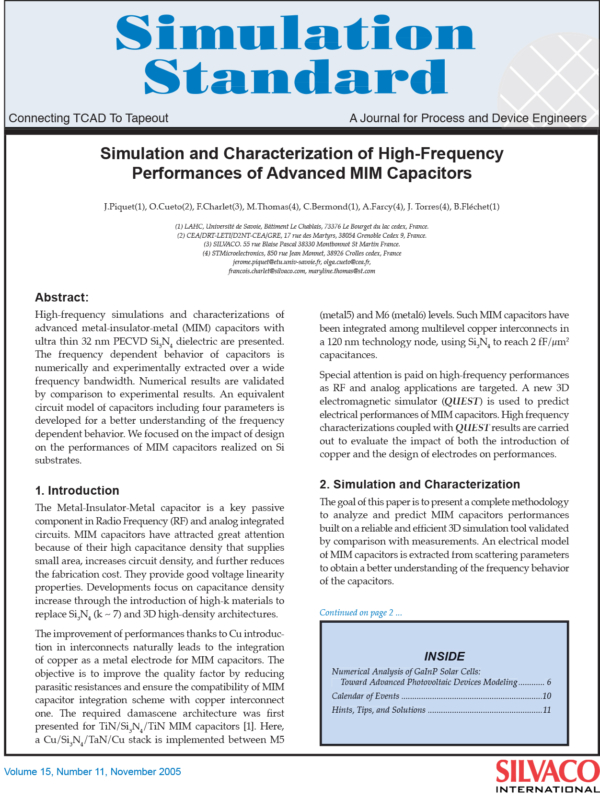Simulation and Characterization of High-Frequency Performances of Advanced MIM Capacitors
J.Piquet(1), O.Cueto(2), F.Charlet(3), M.Thomas(4), C.Bermond(1), A.Farcy(4), J. Torres(4), B.Fléchet(1)
(1) LAHC, Université de Savoie, Bâtiment Le Chablais, 73376 Le Bourget du lac cedex, France.
(2) CEA/DRT-LETI/D2NT-CEA/GRE, 17 rue des Martyrs, 38054 Grenoble Cedex 9, France.
(3) SILVACO. 55 rue Blaise Pascal 38330 Montbonnot St Martin France.
(4) STMicroelectronics, 850 rue Jean Monnet, 38926 Crolles cedex, France
jerome.piquet@etu.univ-savoie.fr, olga.cueto@cea.fr,
francois.charlet@silvaco.com, maryline.thomas@st.com
Abstract:
High-frequency simulations and characterizations of advanced metal-insulator-metal (MIM) capacitors with ultra thin 32 nm PECVD Si3N4 dielectric are presented. The frequency dependent behavior of capacitors is numerically and experimentally extracted over a wide frequency bandwidth. Numerical results are validated by comparison to experimental results. An equivalent circuit model of capacitors including four parameters is developed for a better understanding of the frequency dependent behavior. We focused on the impact of design on the performances of MIM capacitors realized on Si substrates.
Introduction
The Metal-Insulator-Metal capacitor is a key passive component in Radio Frequency (RF) and analog integrated circuits. MIM capacitors have attracted great attention because of their high capacitance density that supplies small area, increases circuit density, and further reduces the fabrication cost. They provide good voltage linearity properties. Developments focus on capacitance density increase through the introduction of high-k materials to replace Si3N4 (k ~ 7) and 3D high-density architectures.
The improvement of performances thanks to Cu introduction in interconnects naturally leads to the integration of copper as a metal electrode for MIM capacitors. The objective is to improve the quality factor by reducing parasitic resistances and ensure the compatibility of MIM capacitor integration scheme with copper interconnect one. The required damascene architecture was first presented for TiN/Si3N4/TiN MIM capacitors [1]. Here, a Cu/Si3N4/TaN/Cu stack is implemented between M5 (metal5) and M6 (metal6) levels. Such MIM capacitors have been integrated among multilevel copper interconnects in a 120 nm technology node, using Si3N4 to reach 2 fF/µm2 capacitances.
Special attention is paid on high-frequency performances as RF and analog applications are targeted. A new 3D electromagnetic simulator (QUEST) is used to predict electrical performances of MIM capacitors. High frequency characterizations coupled with QUEST results are carried out to evaluate the impact of both the introduction of copper and the design of electrodes on performances.
Simulation and Characterization
The goal of this paper is to present a complete methodology to analyze and predict MIM capacitors performances built on a reliable and efficient 3D simulation tool validated by comparison with measurements. An electrical model of MIM capacitors is extracted from scattering parameters to obtain a better understanding of the frequency behavior of the capacitors.



